Drivve | Image program folder, default is "C:\Program Files(x86)\Drivve\Drivve Image".
The following documents give you an overview of the used ports.
- Network communication Sharp OSA 2
- Network communication Sharp OSA 3, 4 and 5
- Network communication Toshiba EWB and EBX
- Network communication Xerox EIP
- Network communication Kyocera HyPAS
- Network communication: Samsung XOA, Canon ScanFront, Fujitsu network scanner, Lexmark
Network Communication: Sharp OSA 2
Device -> Drivve | Image Server
Communication going from the device to the Drivve | Image server is configured in the IIS-Configuration application. The protocols Http/Https and Ftp are used for communication. The following ports are used:
- Http: 9000 (default)
- Https: 4443 (default)
- Ftp: 24 (default)
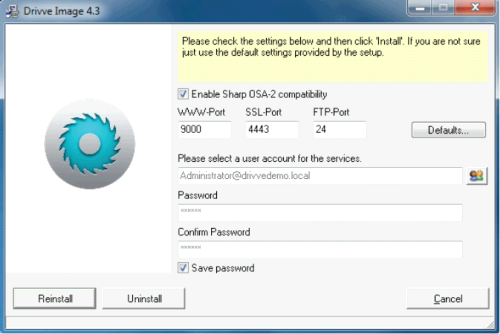
Figure 1: IIC Configuration Application
The ports cannot be configured using the IIS-Configuration application on a Windows XP operating system. In order to change them, you have to change the ports using the Windows IIS Manager.
Regarding Ftp, the configuration is within the Drivve | Image administration application (
Tools > Options).
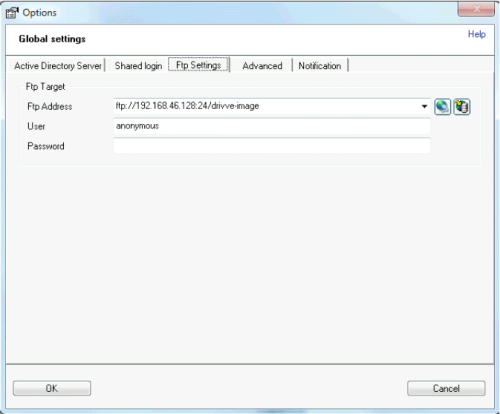
Figure 2: Ftp Settings in
Tools > Options
Warning
Since April 2014, Windows XP is no longer supported
Drivve | Image Server -> Device
Communication going from the Drivve | Image server to the device is configured in the Sharp device web interface under
Security Settings -> Port Control. The Http/Https protocol is used for communication. The following ports are used:
- Http: 80 (default)
- Https: 443 (default)
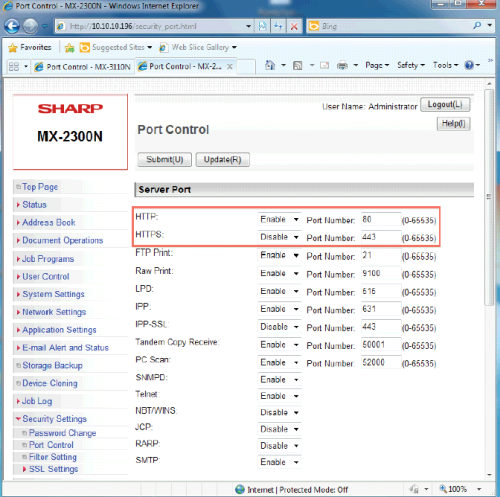
Figure 3: Web administration page of the device
Network communication - schematic overview
The Sharp OSA 2 devices use two different protocols: Http and Ftp.

The Sharp OSA 2 device requires two network protocols, Http/Https and Ftp:
- Http/https is used for requests going from the device to the Drivve | Image server and requests that are sent from the Drivve | Image server to the device.
- Ftp is used to store the scanned document pages to the Drivve | Image server.
The TCP/IP ports used can be configured.
Network Communication: Sharp OSA 3, 4 and 5
Network communication - schematic overview
Sharp OSA 3, 4 and 5 devices only communicate through the Http/Https protocol.
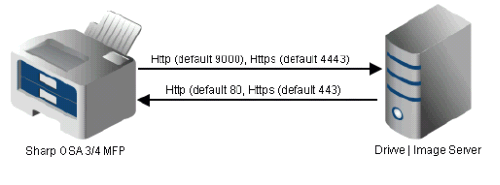
The TCP/IP ports used can be configured.
Communication from the device to the Drivve | Image Server
Communication going from the device to the Drivve | Image server is configured in the IIS-Configuration application.
The Http/Https protocol is used for communication. The following protocols/ports are used:
- Http: 9000 (default)
- Https: 4443 (default)
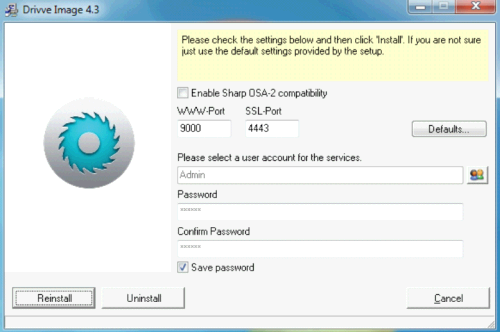
Communication from the Drivve | Image Server to the device
Communication going from the Drivve | Image server to the device is configured in the Sharp device web interface under "Security Settings - Port Control". The Http/Https protocol is used for communication. The following protocols/ports are used:
- Http: 80 (default)
- Https: 443 (default)
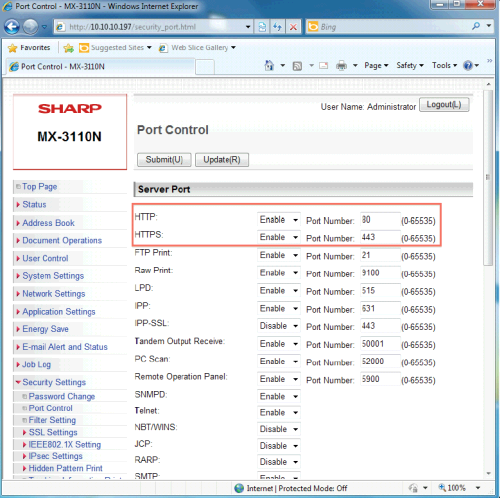
Drivve | Image Device Management
In the Drivve | Image Device Management, the following protocols/ports are used bidirectionally:
- SNMP / Port 161
- HTTPS / Port 443
- HTTP / Port 80
Note
If Drivve | Image cannot retrieve device information using the SNMP protocol, the ARP protocol is used.
Network Communication: Toshiba EWB and EBX
Network communication - schematic overview
Toshiba devices use only the Http/Https protocol. Communication goes into 2 directions:
- Communication from the device to the Drivve | Image server
- Communication from the Drivve | Image server to the device
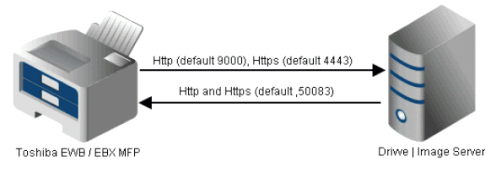
The TCP/IP ports used can be configured.
Communication from the device to the Drivve | Image Server
Communication used by the device to connect to the Drivve | Image server is configured in the IIS-Configuration application. The Http/Https protocol is used for communication.
The following protocols/ports are used:
- Http: 9000 (default)
- Https: 4443 (default)
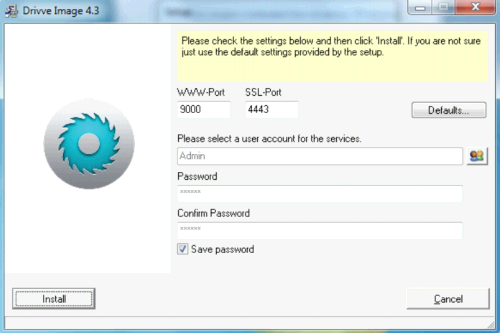
Communication from the Drivve | Image Server to the device
Communication going from the Drivve | Image server to the device is configured in the device administration web interface. For the communication between server and the device, the Http/Https protocol is used. The used port is port 50083 (default).
Drivve | Image Device Management
In the Drivve | Image Device Management, the following ports/protocols (bidirectional use) are supported:
- SNMP / Port 161
- HTTPS / Port 443
- HTTP / Port 9090 (used functions: WSDL/SOAP Web Service)
- IPPS / Port 443
Network Communication: XEROX EIP
Network communication - schematic overview
The Xerox EIP devices use the Http and the Snmp protocol.

The TCP/IP ports used can be configured.
Communication from the device to the Drivve | Image Server
Communication going from the device to the Drivve | Image server is configured in the IIS-Configuration application.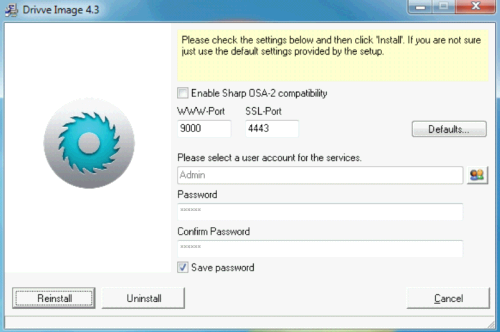
Figure 1: IIS Configuration application
The Http/Https protocol is used for communication. The following ports are used:
- Http: 9000 (default)
- Https: 4443 (default)
Communication from the Drivve | Image Server the device
Communication going from the Drivve | Image server to the device is configured in the Xerox device web interface under
Connectivity - Protocols - Http. The protocols Http and Snmp are used for communication. The following ports are used:
- Http: 443 (default)
- Snmp: 161 (default)
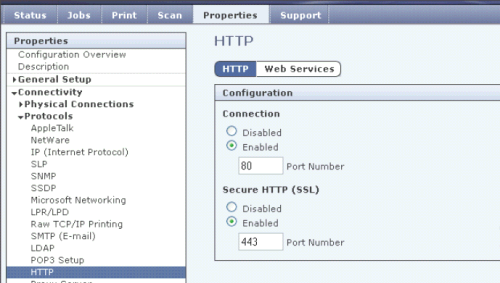
Figure 2: Web administration page of the device
Drivve | Image Device Management
In the Drivve | Image Device Management, the following protokols/ports are used bidirectionally:
- SNMP / Port 161
- HTTPS / Port 443
- HTTP / Port 80
Network Communication: Kyocera HyPAS
Network communication - schematic overview
Kyocera devices use only the Http protocol.

The TCP/IP ports used can be configured
Communication from the device to the Drivve | Image Server
Communication used by the device to connect to the Drivve | Image server is configured in the IIS-Configuration application.
The following protocols/ports are used:
HTTP / Port 9000 or
HTTPS / Port 4443
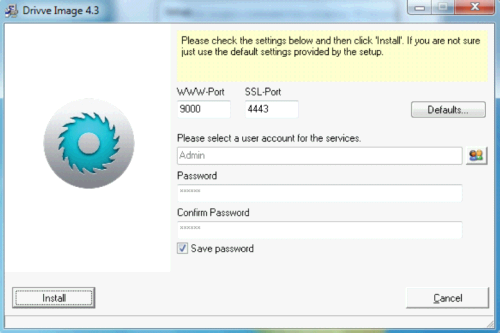
Communication from the Drivve | Image Server to the device
Communication going from the Drivve | Image server to the device uses the following protocols/ports:
- SNMP / Port 161
- HTTPS / Port 8080 JAMP servlet
- HTTP / Port 9090 - WSDL/SOAP Webservice
Drivve | Image Device Management
For the Drivve | Image device management, the following protocols/ports are used bidirectionally:
- SNMP / Port 161
- HTTPS / Port 443
- HTTP / Port 9090 - WSDL/SOAP Webservice
Network Communication: Samsung XOA, Canon ScanFront, Fujitsu Network Scanner, Lexmark
Network communication - schematic overview
The Samsung XOA, Canon ScanFront, Fujitsu Network Scanner and Lexmark devices only use the Http/Https protocol. These devices are the only devices comunicating only in one direction, namely from the device to the Drivve | Image server.

The TCP/IP ports used can be configured.
Communication from the device to the Drivve | Image server
Communication going from the device to the Drivve | Image server is configured in the IIS-Configuration application. The Http/Https protocol is used for communication. The following protocols/ports are used:
- Http: 9000 (default)
- Https: 4443 (default)

Note
On a Windows XP operating system, the ports cannot be configured using the IIS-Configuration application. In order to change the ports, you have to use the Windows IIS Manager.
Warning
Since April 2014, Windows XP is no longer supported
Drivve | Image Device Management
In the Drivve | Image Device Management, the following protocols/ports are used bidirectionally:
- SNMP / Port 161 (not in the case of Fujitsu Network Scanners)
- HTTPS / Port 443
Note: Retrieving device information
Samsung XOA, Canon ScanFront Lexmark:
Fujitsu Network Scanners:
Drivve | Image always tries to retrieve device information using the
.